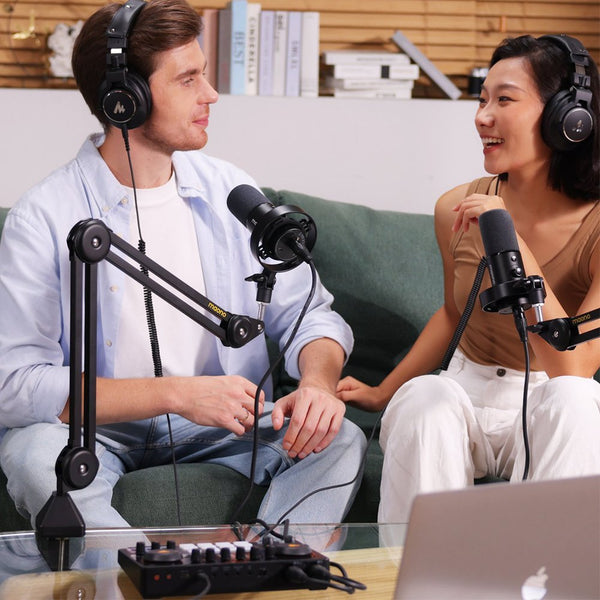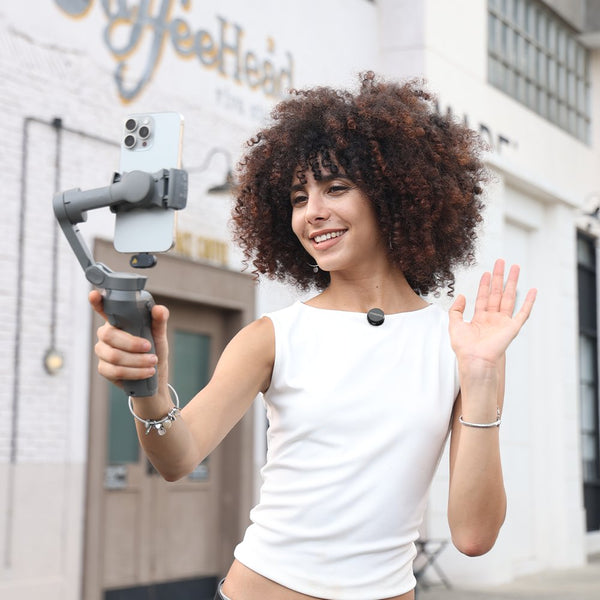In the fast-paced world of social media, expanding your podcast's audience means going beyond audio platforms. One of the most effective ways to grow your reach is by posting engaging video clips of your podcast on platforms like Facebook and Instagram. However, simply uploading random snippets isn’t enough—you need a strategy, high-quality sound, and a consistent posting routine.
This guide will walk you through how to schedule your podcast clips for Facebook and Instagram, improve your sound using the right podcast microphone, and maximize engagement through smart formatting and editing.
Podcasting has exploded in popularity, but discoverability remains a challenge. Repurposing audio content into short, digestible video clips tailored for social media is a proven method to get more eyes (and ears) on your show. Whether you're highlighting a powerful quote, a funny moment, or a compelling question, turning these into social media-ready clips—paired with great audio from the best podcast microphone—can help amplify your message.
How to Schedule Podcast Clips for Facebook and Instagram Automatically
Automating your posting process helps you stay consistent without constant manual work. Use tools like:
-
Meta Business Suite – Schedule Reels and posts on both Facebook and Instagram from one dashboard. Ideal for managing a single brand.
-
Later or Buffer – These platforms support scheduling short videos and allow for previewing your feed layout.
-
Repurpose.io – Automatically turns your podcast episodes into social clips and distributes them across multiple channels.
Make sure you format your clips (MP4, under 90 seconds) correctly to meet platform requirements and reach maximum engagement.
Optimizing Podcast Microphones for Social Media Sound Quality
Even the most visually appealing clip will lose viewers if the audio is muffled, echoey, or full of background noise. When recording clips specifically for social media, your microphone podcast choice and setup matter more than ever.
Tips for optimizing audio quality:
-
Use a podcasting microphone like a condenser mic for crisp, detailed voice capture.
-
Keep mic close to your mouth (6–12 inches).
-
Use a pop filter to reduce plosives.
-
Record in a quiet, treated environment to eliminate echo and background noise.
-
Use audio editing software (like Audacity or Adobe Audition) to clean and balance levels before posting.
Batch Recording & Scheduling Strategy for Weekly Podcast Clips
Time is your most valuable asset. Instead of recording, editing, and posting clips every day, batch content production and scheduling to streamline your workflow.
Weekly Batch Strategy:
-
Select 3–5 standout moments from each podcast episode.
-
Use tools like Descript, CapCut, or Headliner to turn them into vertical video clips.
-
Add captions and branding.
-
Schedule them using Meta Business Suite or a third-party tool.
By batching one week’s worth of clips in a single session, you reduce fatigue, stay consistent, and have time left for engagement and strategy.
How to Repurpose Long Podcast Episodes into Social Media Reels
Long-form podcast content is great for depth, but social media rewards brevity. Here’s how to turn lengthy episodes into impactful Reels:
-
Identify Highlights – Look for quotes, tips, or reactions that spark curiosity or emotion.
-
Use timestamps and editing tools – Cut the episode into short 30–60 second sections.
-
Format for vertical (9:16) video.
-
Add dynamic subtitles and waveform animations to catch attention even when muted.
Apps like VEED.io and Wavve specialize in turning audio into attention-grabbing video snippets.
Facebook vs. Instagram for Podcast Growth: What You Need to Know
While both platforms are valuable, they serve different purposes:
-
Facebook: Better for long-term video visibility, older audiences, and community building (via groups).
-
Instagram: Ideal for younger demographics and high discoverability through Reels.
Tips:
-
Post to both platforms, but slightly tailor your captions.
-
Use hashtags on Instagram for discovery, while Facebook favors shares and comments.
-
Create engaging thumbnails and hooks to stop the scroll.
Affordable Microphones That Work Well for Podcasting & Reels
You don’t need to break the bank for high-quality sound. Two great options include:
Maono A04 USB Condenser Microphone

-
Features: Plug-and-play USB connection, cardioid pickup pattern, shock mount, and pop filter included.
-
Why it's ideal: Perfect for beginners and mobile podcasters creating content for social platforms. Delivers clean, crisp sound while rejecting background noise. It’s considered one of the best microphones for podcasting at its price point.
Maono PM422 USB Condenser Microphone

-
Features: USB and XLR output, gain control, mute button, and monitoring jack.
-
Why it’s ideal: Great for creators who want flexibility between podcasting and live streaming. Offers professional sound quality at an affordable price, making it excellent as a microphone for podcast recording and video content.
Both mics provide superior sound for vlogging, Instagram Reels, Facebook content, and YouTube shorts, earning their place as best podcast microphone options for content creators on a budget.
Using Captions and Audio Filters to Make Podcast Clips More Engaging
Social media videos are often watched without sound, so captions are non-negotiable. Here’s how to enhance engagement:
-
Add auto-captions with tools like CapCut, VEED.io, or YouTube Studio.
-
Use sound filters to clean up background noise or add vocal enhancement.
-
Style your captions with brand fonts or colors to make your clips pop.
-
Include emojis, bold words, and line breaks for readability.
Bonus: Use audio filters that enhance mid-high frequencies to make your voice clearer and more engaging on smaller phone speakers.
FAQ Section
1. How can I automatically schedule podcast clips for both Instagram and Facebook?
Use Meta Business Suite or tools like Later and Buffer to schedule clips for both platforms from one dashboard.
2. What apps or tools help cross-post Reels without quality loss?
Repurpose.io, Descript, and CapCut allow you to export high-quality videos optimized for Reels.
3. Can I post the same podcast clip to Instagram Reels and Facebook Reels at once?
Yes. Meta Business Suite allows you to post simultaneously to both.
4. How far in advance should I schedule podcast content for social media?
At least 1 week ahead is ideal. Batch your clips and schedule them all at once.
5. Is there a free tool for scheduling podcast video snippets?
Meta Business Suite is free and allows scheduling on both Facebook and Instagram.
6. How do I optimize podcast snippets for both Instagram and Facebook formats?
Use vertical format (9:16), include captions, and keep them under 60 seconds.
7. What's the best aspect ratio for posting podcast clips on both platforms?
9:16 (vertical) works best for Reels and Stories.
8. How do I add captions to podcast clips for Instagram and Facebook?
Use CapCut, VEED, or auto-caption features in YouTube and Instagram.
9. Should I post the same clip at different times on each platform?
You can experiment with timing, but it’s okay to post simultaneously with platform-specific captions.
10. What are the best practices for batching and scheduling podcast content weekly?
Pick highlights from one episode, edit all clips in one session, and schedule them using Meta Business Suite.
11. Can I use a USB microphone for podcasting and recording Instagram content?
Yes, especially models like the Maono A04 and PM422 which offer great quality and easy setup.
12. How do I reduce background noise when recording podcast reels?
Use cardioid mics, record in quiet spaces, and apply noise reduction in post.
13. What’s the ideal microphone placement for filming podcast clips?
6–12 inches from your mouth, slightly off-axis to reduce plosives.
14. Do I need a pop filter when filming podcast clips for social platforms?
Yes. It reduces harsh “p” and “b” sounds, making audio more professional.
15. How can I sync my audio with video if I record separately?
Use claps as markers and sync in editing software like Adobe Premiere Pro or DaVinci Resolve.
16. What microphone is best for recording clips that will be shared on social media?
USB mics like the Maono A04 or PM422 offer great audio with minimal setup—ideal for short-form content and recommended as best microphone for podcasting across platforms.
Conclusion
Growing your podcast isn’t just about great conversations—it’s about delivering them effectively across platforms your audience actually uses. Facebook and Instagram are powerful channels to promote your episodes, and by scheduling clips, optimizing your audio with a microphone for podcast recording, and formatting content for engagement, you can significantly expand your reach.
Start small: pick one episode, create three strong clips, and post them consistently with captions and clean audio from the best podcast microphone you can access. With the right setup and strategy, your podcast will not just be heard—but seen and shared across the platforms that matter most.



